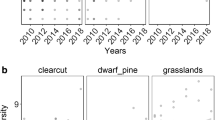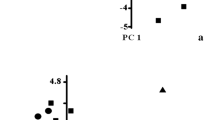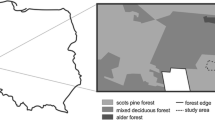Abstract
We investigated central Mediterranean Pinus halepensis plantations under semi-arid climate in order to evaluate the combined effect of soil treatment and afforestation practices on spontaneous plant species composition, richness and evenness, and on the trend and speed of vegetation dynamics. Phytosociological relevés of three different plot typologies, i.e. (1) soil-treatment and plantation, (2) only soil-treatment, (3) no soil-treatment and no plantation, were compared by (a) multivariate analysis and (b) with reference to species richness and evenness. Moreover, in order to compare vegetation dynamics within the plantations with those ones ongoing in semi-natural garrigue communities, we compared life form and syntaxonomic spectra between phytosociological relevés taken at 8 years of distance. DCA showed that floristic species composition and similarity are influenced by the canopy cover of Pine trees as well as by soil-treatment practices. Although species richness and evenness are not clearly related to neither soil treatment nor Pine afforestation, canopy cover clearly plays a major role: in fact, the highest Ph cover rates correspond to the lowest values of understory species richness. This is true also if only species of biogeographical/conservation interest are considered. Regarding vegetation dynamics, sites with dense Pine canopy cover evolve much slower than the adjacent garrigue communities. The same factors invoqued to explain the patterns of floristic composition and similarity (i.e. allelopathy and competition for light, water and nutrients) may also explain the lowering of diversity of therophytes and the strong decline of the cover perfomed by both therophytes and hemicryptophytes underneath the canopy of dense Ph plantations. Thus, in sites where Ph cover exceeds about 80%, thinning is recommended not only in order to accelerate succession, but also to give a natural ‘shape’ to afforestations.
Similar content being viewed by others
References
Alrababah MA, Alhamad MA, Suwaileh A, Al-Gharaibeh M. 2007. Biodiversity of semi-arid Mediterranean grasslands: impact of grazing and afforestation. Applied Vegetation Science, 1(2): 257–264.
Andrés C, Ojeda F. 2002. Effects of afforestation with pines on woody plant diversity of Mediterranean heathlands in southern Spain. Biodiversity & Conservation, 11: 1511–1520.
Bartolo G, Brullo S, Minissale P, Spampinato G. 1986. Osservazioni fitosociologiche sulle pinete a Pinus halepensis Miller del bacino del fiume Tellaro (Sicilia sud-orientale). Bollettino dell’Accademia Gioenia di Scienze Naturali, s. 4, 18(325) (1985): 255–270.
Battles JJ, Shlisky AJ, Barrett RH, Heald RC, Allen-Diaz BH. 2001. The effects of forest management on plant species diversity in a Sierran conifer forest. Forest Ecology and Management, 146: 211–222.
Bellot J, Maestre FT, Chirino E, Hernández N, de Urbina JO. 2004. Afforestation with Pinus halepensis reduces native shrub performance in a Mediterranean semiarid area. Acta Oecologica, 25(1–2): 7–15.
Benabdeli K. 1998. First dendrometrical results of Aleppo pine plantation (Pinus halepensis Mill.) in the Green Barrage (Aflou Algeria). Ecologia Mediterranea, 24: 43–51.
Bianchi L, Calamini G, Gregori E, Paci M, Pallanza S, Pierguidi A, Salbitano F, Tani A, Vedele S. 2002. Valutazione degli effetti del rimboschimento in zone aride della Sardegna: risultati preliminari sulla vegetazione. Italia Forestale e Montana, 57(4): 353–368.
Braun-Blanquet J. 1932. Plant sociology. New York-London: Mc Graw-Hill
Camargo JA. 1993. Must dominance increase with the number of subordinate species in competitive interactions? Journal of Theoretical Biology, 161: 537–542.
Canadell J, Djema A, López B, Lloret F, Sabaté S, Siscar D, Gracia CA. 1999. Structure and dynamic of the root system. In: Rodá, F., Retana, J., Gracia, C.A., Bellot, J. (Eds.), Ecology of Mediterranean Evergreen Oak Forests. Ecological Studies 137. Berlin-Heidelberg: Springer, pp. 47–59.
Chamard P, Ciattaglia L, Di Sarra A, Grigioni P, Monteleone F. Sarao R. 1998. The ENEA Station for climate observations at Lampedusa. Roma-Italy: Conferenza Nazionale Energia e Ambiente, p.10.
Chiarucci A, De Dominicis V. 1995. Effects of pine plantations on ultramafic vegetation of central Italy. Israel Journal of Plant Sciences, 43: 7–20.
Chirino E, Bonet A, Bellot J, Sánchez JR., 2006. Effects of 30-year-old Aleppo pine plantations on runoff, soil erosion, and plant diversity in a semi-arid landscape in south eastern Spain. Catena, 65(1): 19–29.
Conti F, Abbate G, Alessandrini A, Blasi C. (eds.) 2005. An Annotated Checklist of the Italian Vascular Flora. Ministero dell’Ambiente e della Tutela del Territorio, Direzione per la Protezione della Natura. Palombi Ed., Roma, p.420.
Conti F, Manzi A, Pedrotti F. 1997. Liste Rosse Regionali delle Piante d’Italia. Camerino: W.W.F., Soc. Bot. Ital., p.139.
Corona P, Ferrari B, Iovino F, La Mantia T, Barbati A. 2009. Rimboschimenti e lotta alla desertificazione In Italia. Roma: Aracne Edritice, p.281.
Fabbio G, Merlo M, Tosi, V., 2003. Silvicultural management in maintaining biodiversity and resistance of forests in Europe — the Mediterranean region. Journal of Environmental Management, 67: 67–76.
FAO 2006. Planted Forests and Trees Working Paper FP37E. Responsible Management of Planted Forests, Voluntary Guidelines. Rome: FAO, United Nations.
Fernandez C, Lelong B, Vila B, Mévy J-P, Robles C, Greff S, Dupoyet S, Bousquet-Mélou A. 2006. Potential allelopathic effect of Pinus halepensis in the secondary succession: an experimental approach. Chemoecology, 16(2): 97–105.
Fernández E, Rojo L, Jiménez MN, Navarro FB, Díez M, Martín F, Fernández J, Martínez J, Roca A, Aguilar J. 2010. Afforestation improves soil fertility in south-eastern Spain. European Journal of Forest Research, 194(4): 707–717.
GarfÌ V, Iovino F, Menguzzato G, Nicolaci A. 2002. Preparazione del suolo e densità di impianto in rimboschimenti di pino d’Aleppo e di pino laricio: analisi e primi risultati. Italia Forestale e Montana, 57(4): 319–338.
Gil L, Aránzazu Prada M. 1993. Los pinos como especies básicas en la restauración forestal en el medio mediterráneo. Ecología, 7: 113–125.
Ginsberg P. 2006. Restoring biodiversity to pine afforestations in Israel. Journal for Nature Conservation, 14(3–4): 207–216.
Grammatikopoulos G, Petripoulou Y, Manetas Y. 1999. Site-dependent differences in transmittance and UV-B absorbing capacity of isolated leaf epidermis and mesophyll in Urginea maritima (L.) Baker. Journal of Experimental Botany, 50: 517–521.
Grasso M, Pedley HM. 1988. Carta Geologica dell’Isola di Lampedusa. Ministero della Pubblica Istruzione e Regione Sicilia, S.E.L.C.A. Firenze.
Grime JP. 2001. Plant Strategies, Vegetation processes and Ecosystem Properties, 2nd ed., West Sussex: J. Wiley & Sons.
Grünzweig JM, Gelfand I, Fried Y, Yakir D. 2007. Biogeochemical factors contributing to enhanced carbon storage following afforestation of a semiarid shrubland. Biogeosciences, 4: 891–904.
Gussone G. 1839. Notizie sulle isole di Linosa, Lampione e Lampedusa, e descrizione di una nuova specie di Stapelia che trovasi in questa ultima, lette nell’anno 1832. Atti della Reale Accademia delle Scienze, Sezione della Società Reale Borbonica, 4: 74–97.
Harrington CA. 1999. Forests planted for ecosystem restoration or conservation. New Forests, 17: 175–190.
Jeddi K, Chaieb M. 2010. Soil properties and plant community in different ages Pinus halepensis Mill. Plantations in arid Mediterranena areas: the case of southern Tunisia. Land Degradation & Development, 21: 32–39.
Krebs CJ. 1999. Ecological Methodology, 2nd ed.. Menlo Park: Benjamin/Cummings, p.620.
La Mantia T, Carimi F, Di Lorenzo R, Pasta S. 2011. The agricultural heritage of Lampedusa (Pelagie Archipelago, South Italy) and its key role for cultivar and wildlife conservation. Italian Journal of Agronomy, 6(2): 106–110.
La Mantia T., Pasta S., Rühl J. 2009. Parte I — Fase conoscitiva — Flora e vegetazione, habitat comunitari, uso del suolo — del Piano di Gestione “Isole Pelagie”, POR 1999.IT.16.1.PO.011/1.11/11.2.9/0304. Legambiente-Comitato Regionale Siciliano e Dipartimento di Colture Arboree dell’Università degli Studi di Palermo (http://www.artasicilia.eu/web/natura2000/index.html).
Le Houérou HN. 2000. Restoration and rehabilitation of arid and semiarid Mediterranean ecosystems in North Africa and West Asia: a review. Arid Soil Research and Rehabilitation, 14: 3–14.
Maestre FT, Cortina J. 2004. Are Pinus halepensis plantations useful as a restoration tool in semi-arid Mediterranean areas? Forest Ecology & Management, 198(1–3): 303–317.
Maestre FT, Cortina J, Bautista S. 2007. Mechanisms underlying the interaction between Pinus halepensis and the native late-successional shrub Pistacia lentiscus in a semi-arid plantation. Ecography, 27(6): 776–786.
Moreno D, Croce GF, Guido MA, Montanari C., 1993. Cap. 7. Pine plantations on ancient grassland: ecological changes in the Mediterranean mountains of Liguria, Italy, during the 19th and 20th centuries. In: Watkins, C. (ed.), Ecological effects of afforestation. Studies in the history and ecology of afforestation in Western Europe. Oxford: CAB. International.
Navarro-Cano JA, Barberá GG, Ruiz-Navarro A, Castillo VM. 2009. Pine plantation bands limit seedling recruitment of a perennial grass under semiarid conditions. Journal of Arid Environments, 73: 120–126.
Ne’eman G, Trabaud L (eds.). 2000. Ecology, biogeography and management of Pinus halepensis and P. brutia forest ecosystems in the Mediterranean Basin. Leiden: Backhuys Publishers, p.407.
Nektarios PA, Economou G, Avgoulas C. 2005. Allelopathic effects of Pinus halepensis needles on turfgrasses and biosensor plants. Hortscience, 40(1): 246–250.
Noy-Meir I. 1989. An ecological viewpoint on afforestation in Israel: past and future. Allgemeine Forst Zeitschrift, 24–26: 614–618.
Pantis JD, Mardiris TA. 1993. The effects of grazing and fire on degradation processes of Mediterranean ecosystems. Israel Journal of Botany, 41: 233–242.
Paola G, Barberis G, Peccenini S. 1991. Pinus halepensis formations in Liguria (NW Italy). Botaniká Chroniká, 10: 609–615.
Pasta S, La Mantia T. 2001. Note sul paesaggio vegetale delle isole minori circumsiciliane. I. Consorzi forestali e preforestali dell’isola di Lampedusa ed effetto degli impianti artificiali sulla vegetazione forestale. Il Naturalista siciliano, 25(suppl.): 71–89.
Pasta S, La Mantia T. 2004. Note sul paesaggio vegetale delle isole minori circumsiciliane. II. La vegetazione pre-forestale e forestale nelle isole del Canale di Sicilia. Annali dell’Accademia Italiana di Scienze Forestali, 52 [2003]: 77–124.
Peco B, Levassor C, Pineda F.D. 1983. Diversité et structure spatiale de pâturages méditerranéens en cours de succession. Ecol Medit, 9: 223–234.
Pignatti G. 1993. Diversità floristica in formazioni forestali artificiali mediterranee. Italia Forestale e Montana, 48(5): 272–283.
Pignatti S. 1982. Flora d’Italia. Bologna, Edagricole, 3 voll..
Prévosto B, Bousquet-Mélou A, Ripert C, Fernandez C. 2011. Effects of different site preparation treatments on species diversity, composition and plant traits in Pinus halepensis woodlands. Plant Ecology, 212(4): 627–638.
Puerto A, Rico M. 1997. Soil depth as determinant of structural trends in Mediterranean grasslands with abundant slaty outcrops. Ekológia, 16: 3–16.
Raunkiær C. 1934. The life-forms of plants and statistical plant geography. Oxford: Oxford University Press.
Rhizopoulou S, Pantis JD, Triantafylli E, Vokou D. 1997. Ecophysiological adaptations of Asphodelus aestivus to Mediterranean climate periodicity water relations and energetic status. Ecography, 20: 626–633.
Rivas-Martínez S. 2008. Global bioclimatics (Clasificación biclimática de la Tierra) (versión 01-12-2008). Available at: http://www.globalbioclimatics.org (last access 19-08-2011).
Rivas-Martínez S, Fernández-Gonzáles F, Loidi J. 1999. Checklist of plant communities of Iberian Peninsula, Balearic and Canary Islands to suballiance level. Itinera Geobotanica, 13: 353–451.
Shi S, Gu JX. 2007. Ecohydrological functions of litter in three main plant communities on Songen grassland. Chinese Journal of Applied Ecology, 18: 1722–1726.
ter Braak CJF, Smilauer P. 2002. CANOCO Reference Manual and Cano-Draw for Windows User’s Guide: Software for Canonical Community Ordination (version 4.5). Ithaca NY, USA, Microcomputer Power.
Tutin TG, Heywood VH, Burges NA, Chater AO, Edmonson JR, Heywood VH, Moore DM, Valentine DH, Walters SM, Webb DA. (eds). 1993. Flora Europaea. Ed. 2, Vol. 1, Cambridge, London, New York, Melbourne: Cambridge University Press.
Tutin TG, Heywood VH, Burges NA, Valentine DH, Walters SM, Webb DA. (eds.) et Coll., 1964–1980. Flora Europaea. Cambridge, London, New York, Melbourne: Cambridge University Press,.
van der Maarel E. 1979. Transformation of cover-abundance values in phytosociology and its effect on community similarity. Vegetatio, 39: 97–114.
Verdaguer D, Sala A, Vilà M. 2010. Effect of environmental factors and bulb mass on the invasive geophyte Oxalis pes-caprae development. Acta Oecologica, 36: 92–99.
Author information
Authors and Affiliations
Corresponding author
Rights and permissions
About this article
Cite this article
Salvatore, P., Mantia, T.L. & Rühl, J. The impact of Pinus halepensis afforestation on Mediterranean spontaneous vegetation: do soil treatment and canopy cover matter?. Journal of Forestry Research 23, 517–528 (2012). https://doi.org/10.1007/s11676-012-0292-y
Received:
Accepted:
Published:
Issue Date:
DOI: https://doi.org/10.1007/s11676-012-0292-y




